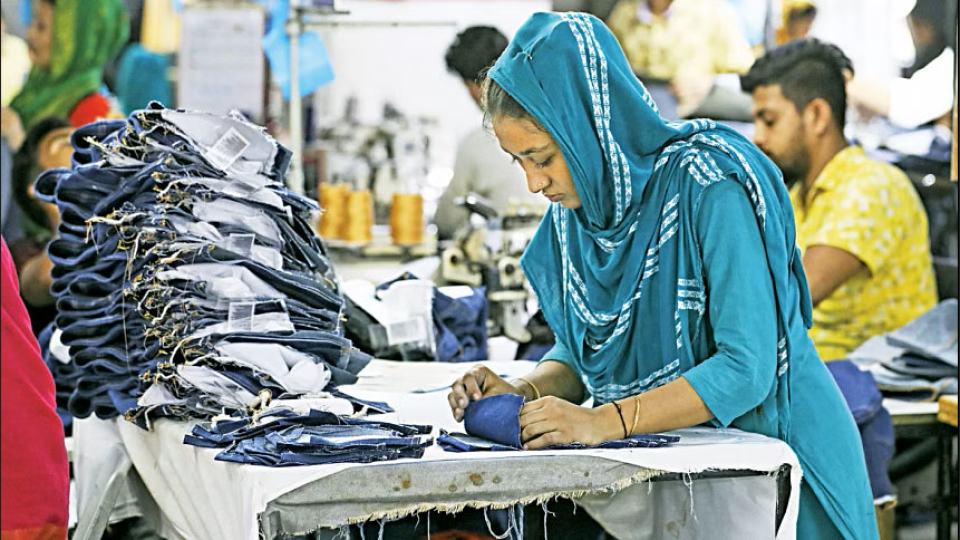May 8, 2023
DHAKA – Despite some progress, Bangladesh has not been able to diversify its export basket compared to its competitors, leading to more concentration in the textiles sector, according to a new report.
Compared to rivals, Bangladesh has emerged as the most concentrated in terms of exports, indicating a relatively high specialisation toward specific products in the textile sector.
Although there has been a tendency toward diversification in recent years, concentration was still higher in 2020 than in the early 2000s, said the “Bangladesh Global Value Chain Report: Transforming Participation in Trade and Global Value Chains”, jointly published by the Asian Development Bank and the Islamic Development Bank Institute.
The report was launched at the InterContinental Dhaka yesterday.
Bangladesh fell below the world average in terms of trade openness despite being the second-largest apparel exporter in the world. It lagged behind competitors such as Cambodia, India, Pakistan, and China.
Thus, increasing international trading activities of the country’s other sectors presents a viable option to attain further growth, according to the report.
The United States, Germany, and the United Kingdom have been the top destinations for Bangladesh’s exports, with textile products dominating the trade. The list of top-recipient economies has still been the same regardless of whether the content of Bangladesh’s exports was dominated by domestic or foreign value-added.
The report stated that Bangladesh’s global value chain (GVC) participation rate was relatively low, falling below the world average by around 20 percentage points.
“Further, backward participation has also outweighed forward participation throughout the years, implying that Bangladesh is located at more downstream stages of the GVCs it participates in.”
From the value-added-based analysis, it is also seen that Bangladesh was more on par with its competitors like Cambodia and Pakistan in terms of export concentration.
Even though the textiles sector still comprised a major share of value-added exports, a more balanced distribution was observed, with sectors such as agriculture, wholesale, post and telecommunications and finance making larger contributions to export production.
For Bangladesh, along with its impending graduation from the grouping of the least-developed countries (LDCs) in November 2026, comes the challenge of discontinuation of benefits granted by preferential trading schemes.
With more favourable rules of origin being established in 2011 as part of the Everything but Arms agreement, a substantial increase in the European Union-based preference utilisation immediately followed. For example, textile products exported to the EU amounted to $17.3 billion in 2021.
“Thus, a considerable amount of export-driven income is being threatened by the imminent erosion of preferences,” the report said.
As an alternative, the report suggested, Bangladesh can diversify its export destinations and expand market access by entering into new treaties such as regional trade agreements.
Zaidi Sattar, chairman of the Policy Research Institute of Bangladesh, said since the second world war, trade has been the engine of global growth and global value chain growth.
“Global value chain contributes to trade growth and trade growth is instrumental in the global economic growth. So, they are interlinked.”
He said the rule-based trade order helped generate income and spurred globalisation and dismantling barriers in trade gave the opportunity to create value chain integration.
“But, now new terms such as reshoring, friend-shoring and strategic autonomy are emerging, leading to a fragmented globalisation. This is not good for the global value chain, global growth and international trade.”
It is also not good for Bangladesh, said Sattar, adding that Bangladesh has been a big beneficiary of international trade and global growth.
The economist said the US-China trade tension is raising the cost of trade and the cost of production, forcing customers to pay higher prices for goods and services.
“To survive and prosper, we need a regional value chain. It would be more cost-efficient than the global value chain, giving a greater efficiency dividend.”
According to Sattar, the challenge for diversification remains in Bangladesh and it is due to the tariff structure.
“Tariffs are really hurting exports diversification and the overall economy, business and investment.”
He recommended the government take a ‘leap of faith’ in restructuring tariffs, paving the way for other sectors to grow like the garment sector.
Prof Shamsul Alam, state minister for planning, and Edimon Ginting, country director of the ADB, also spoke.


